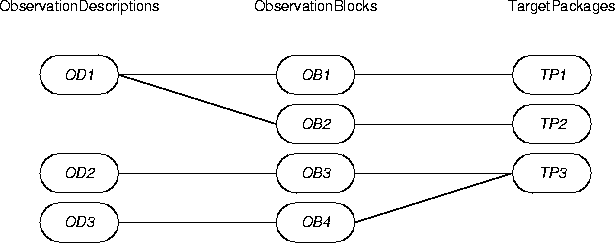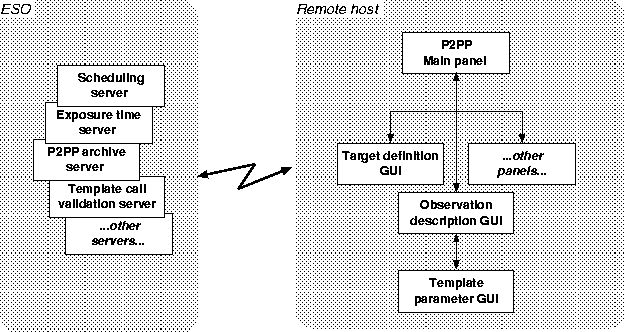Next: Filtering KPNO LaTeX Observing Proposals with Perl
Previous: The Sociology of Astronomical Publication Using ADS and ADAMS
Up: Proposal Processing
Table of Contents - Index - PS reprint - PDF reprint
Astronomical Data Analysis Software and Systems VI
ASP Conference Series, Vol. 125, 1997
Editors: Gareth Hunt and H. E. Payne
A. M. Chavan and M. A. Albrecht
European Southern Observatory, Karl-Schwarzschild-Str. 2,
D-85748 Garching, Germany; E-mail: amchavan@eso.org
Abstract:
A significant fraction of observing time on ESO's new Very Large
Telescope will be spent in service mode; therefore, investigators
need to describe in detail what they want to observe, and how.
ESO is prototyping a distributed ``Phase II'' system that will allow
astronomers to prepare their observations at their home
institutions, while maintaining a central repository for all
observation data. Astronomers will be offered a wide array of
observation preparation tools, including data entry GUIs,
instrument simulators, and catalog interfaces.
The system is structured as a set of distributed clients and
centralized servers, and it operates as a front-end to the other
elements of the VLT Data Flow System.
In order to maximize the scientific throughput of the system, a
complex and expensive observatory like ESO's VLT should let the most
demanding observing programmes take advantage of the very best weather
conditions. Traditionally, this has not been possible: observers have
had to cope with the atmospheric conditions prevailing during the night
assigned to them. ESO is experimenting with operating telescopes in
service observing mode, whereby staff observers execute
scientific programmes on behalf of the investigators (this mode of
operation is also called queue observing).
To make service mode observing possible, scientific programmes must be
described in great detail-a process commonly defined as Phase
II proposal preparation. ESO is developing a Phase II Proposal
Preparation system (P2PP) to collect detailed scientific
programme descriptions, in the form of observation blocks (OB).
The system is initially directed to support service mode observing
(that is, a significant fraction of the VLT observations), but will
eventually be used by ``classical mode'' observers as well: OBs will
be the main input to the VLT's Data Flow System (Grosbøl & Peron 1997).
VLT observing programmes will be composed of several observation
blocks, each coupling a target ( what should be observed) with
a description of how the observation itself should be carried
on; observation blocks represent a high level view of VLT operations.
Several scheduling constraints may be specified for OBs, like worst
acceptable seeing, absolute timing for transient phenomena, chaining
of observations, maximum acceptable airmass, etc.
Targets (technically target packages) are described in terms of
coordinates, proper motion, magnitude, color, and all other
information which may be needed to acquire them and track them during
exposure. This includes one or more guide stars.
The observation description is composed of series of standard
operations, called templates: typical templates include target
acquisition, science exposures, and calibration frames. For each
template to be executed, astronomers need to specify a set of
parameters, like filter names, exposure times, CCD readout mode, etc.
These parameters specify a full instrumental configuration as well as
execution details, like the pattern of images for a mosaic template.
Targets and observation descriptions can be shared among OBs, as shown
in Figure 1, thus allowing astronomers to easily group
related observations.

Figure: Targets TP1 and TP1 are observed in the same way, since observation
blocks OB1 and OB2 share the same observation description, OD1.
Conversely, TP3 is shared by two observation blocks, OB3 and OB4.
The investigator wishes to observe the same target in two different
ways: e.g., with an optical imager and with a spectrograph.
Original PostScript figure (17kB).
For privacy and reliability of information, observation blocks will
be stored in a central repository at ESO. Other important services,
like instrument simulators, data servers (Albrecht, Brighton, &
Herlin 1997), and help
pages, will be provided centrally by ESO as well. However, it is
imperative that (a) P2PP can take advantage of the investigators' own
computing facilities, and (b) astronomers can prepare their
observations even when they are not connected to the Internet. These
requirements dictate the design of a distributed, client-server
system: ``lightweight'' clients interact with central servers, and can
maintain a local cache of information.
The P2PP system is therefore a collection of independent stand-alone
modules, structured in a client/server relationship. The server
modules run at ESO and handle centralized services, like database
access for OB storage, exposure time calculation, etc., while client
modules run on the OB's author's host.
Most client modules generate, display, and process part of an OB's
information content: there is a module for describing targets, one for
observations descriptions, etc. One special client module is
used for global OB operations, like transfer of OBs to and from the
central (ESO) database.
All modules offer a graphical user interface. The overall software
architecture is shown in Figure 2. P2PP is being implemented
in C++ and Tcl/Tk; it uses HTTP as the communication protocol between
clients and servers.

Figure: P2PP architecture. Original PostScript figure (31kB).
ESO's Phase II Proposal Preparation system is an integral part of the
VLT Data Flow System (DFS). Observation blocks are built on the basis
of information collected by the Phase I Proposal Handling and
Reporting System (Chavan 1995), and are fed downstream to the VLT
Scheduling Tools (Chavan 1996)-which we are developing in
cooperation with the Space Telescope Science Institute-and to the
VLT Control Software.
All other subsystems of the DFS-including archiving, pipeline
processing, and quality control-deal with observation blocks as well:
OBs represent the basic quantum of information flowing through the VLT
system.
The first operational version of P2PP will support preparation of
observations for the ESO's 3.5m New Technology Telescope, and will be
made available in January 1997. The first VLT version of the system
will be delivered in the spring of 1998.
The Web is already an important enabling technology. In the future, we
hope to be able to use tools like the Java programming language to
provide distributed tools that will run transparently on different
hosts.
Acknowledgments:
We are grateful to the members of the ESO Data Flow Project Team for
the long discussions during which the concepts described here were
defined.
References:
Albrecht, M., Brighton, A., & Herlin, T. 1997, this volume
Chavan, A. M., & Albrecht, M. A.
1995, in Astronomical Data Analysis Software and Systems IV, ASP Conf. Ser., Vol. 77, eds. R. A. Shaw, H. E. Payne & J. J. E. Hayes (San Francisco, ASP), 58
Chavan, A. M., Johnston, M., & Albrecht, M. A. 1996, in
ASP Conf. Ser., Vol. 87,
New Observing Modes for the Next Century,
ed. T. A. Boroson, J. K. Davies, & E. I. Robson (San Francisco:
ASP)
Grosbøl, P., & Peron, M. 1997, this volume
© Copyright 1997
Astronomical Society of the Pacific,
390 Ashton Avenue, San Francisco, California 94112, USA
Next: Filtering KPNO LaTeX Observing Proposals with Perl
Previous: The Sociology of Astronomical Publication Using ADS and ADAMS
Up: Proposal Processing
Table of Contents - Index - PS reprint - PDF reprint
payne@stsci.edu

